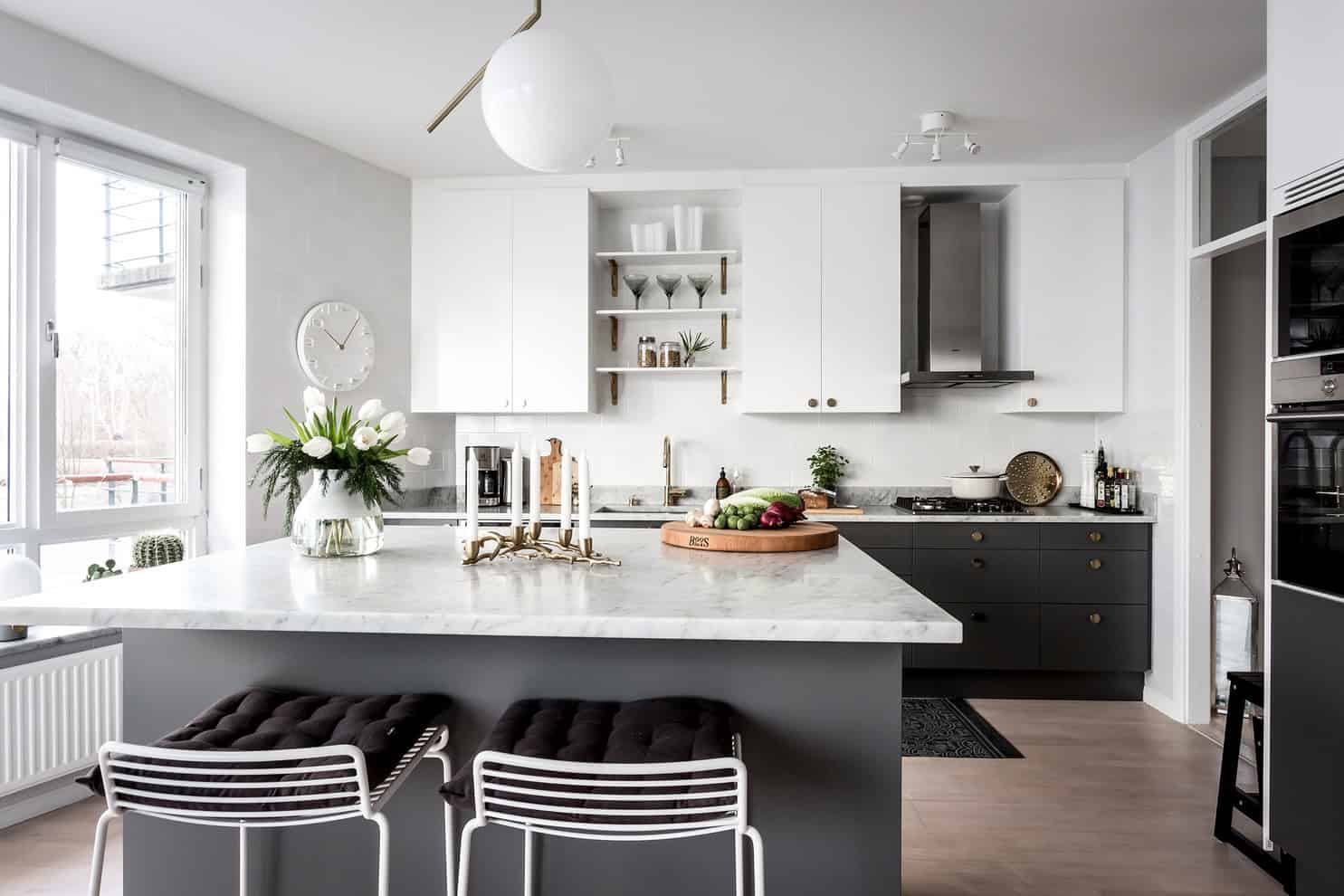Origins of Scandinavian Minimalism

Scandinavian minimalism has its roots in the post-World War II era, when resources were scarce and functionality was a top priority. Designers such as Arne Jacobsen, Eero Saarinen, and Alvar Aalto created furniture and interiors that were simple, yet elegant and functional. This design movement was characterized by the use of natural materials, minimal ornamentation, and an emphasis on simplicity and clean lines.
Key Elements of Scandinavian Minimalist Kitchen
So, what makes a Scandinavian minimalist kitchen? Here are some key elements to consider:
- Neutral Color Palette: A Scandinavian minimalist kitchen typically features a neutral color palette, with a focus on whites, creams, and grays. These colors create a sense of calm and serenity, while also reflecting light and making the space feel larger.
- Natural Materials: Natural materials such as wood, stone, and plants are often used in Scandinavian minimalist kitchens. These materials add warmth and texture to the space, while also creating a sense of connection to nature.
- Simple Cabinetry: Simple, handle-less cabinetry is a hallmark of Scandinavian minimalist kitchens. This style of cabinetry creates a clean and minimalist look, while also providing ample storage for kitchen essentials.
- Minimal Ornamentation: Scandinavian minimalist kitchens are characterized by a lack of ornamentation, with a focus on clean lines and simple shapes. This creates a sense of calm and serenity in the space, while also making it feel more spacious.
- Functional Lighting: Functional lighting is a key element of Scandinavian minimalist kitchens. This style of lighting provides ample illumination for cooking and food preparation, while also creating a sense of ambiance and warmth in the space.
Benefits of Scandinavian Minimalist Kitchen
So, why should you consider a Scandinavian minimalist kitchen for your own home? Here are some benefits to consider:
- Sense of Calm and Serenity: Scandinavian minimalist kitchens are designed to create a sense of calm and serenity, making them the perfect space for cooking and entertaining.
- Increased Functionality: The emphasis on simplicity and functionality in Scandinavian minimalist kitchens means that every element has a purpose, making the space more efficient and effective.
- Easy to Maintain: With a focus on clean lines and minimal ornamentation, Scandinavian minimalist kitchens are easy to clean and maintain, making them perfect for busy homeowners.
- Timeless Design: Scandinavian minimalist kitchens are characterized by a timeless design aesthetic, which means that they will not go out of style anytime soon.
How to Incorporate Scandinavian Minimalist Style into Your Own Kitchen
So, how can you incorporate Scandinavian minimalist style into your own kitchen? Here are some tips to consider:
- Start with a Neutral Color Palette: Begin by selecting a neutral color palette, with a focus on whites, creams, and grays. This will create a sense of calm and serenity in the space, while also reflecting light and making the space feel larger.
- Incorporate Natural Materials: Incorporate natural materials such as wood, stone, and plants into your kitchen design. These materials add warmth and texture to the space, while also creating a sense of connection to nature.
- Select Simple Cabinetry: Choose simple, handle-less cabinetry for your kitchen. This style of cabinetry creates a clean and minimalist look, while also providing ample storage for kitchen essentials.
- Add Functional Lighting: Add functional lighting to your kitchen, such as under-cabinet lighting or pendant lights. This style of lighting provides ample illumination for cooking and food preparation, while also creating a sense of ambiance and warmth in the space.
Frequently Asked Questions (FAQ)
Q: What are the key elements of a Scandinavian minimalist kitchen?
A: The key elements of a Scandinavian minimalist kitchen include a neutral color palette, natural materials, simple cabinetry, minimal ornamentation, and functional lighting.
Q: What are the benefits of a Scandinavian minimalist kitchen?
A: The benefits of a Scandinavian minimalist kitchen include a sense of calm and serenity, increased functionality, easy maintenance, and a timeless design aesthetic.
Q: How can I incorporate Scandinavian minimalist style into my own kitchen?
A: To incorporate Scandinavian minimalist style into your own kitchen, start with a neutral color palette, incorporate natural materials, select simple cabinetry, and add functional lighting.
Q: What type of lighting is best for a Scandinavian minimalist kitchen?
A: Functional lighting, such as under-cabinet lighting or pendant lights, is best for a Scandinavian minimalist kitchen. This style of lighting provides ample illumination for cooking and food preparation, while also creating a sense of ambiance and warmth in the space.
Q: What type of materials are best for a Scandinavian minimalist kitchen?
A: Natural materials, such as wood, stone, and plants, are best for a Scandinavian minimalist kitchen. These materials add warmth and texture to the space, while also creating a sense of connection to nature.
Conclusion
In conclusion, the Scandinavian minimalist kitchen is a masterclass in simplicity and elegance, characterized by its emphasis on clean lines, natural materials, and functional lighting. This design aesthetic has gained popularity worldwide for its ability to create a sense of calm and serenity in the heart of the home. By incorporating the key elements of Scandinavian minimalist style into your own kitchen, you can create a space that is not only beautiful, but also functional and efficient. Whether you’re looking to renovate your existing kitchen or build a new one from scratch, the Scandinavian minimalist kitchen is definitely worth considering. With its timeless design aesthetic and emphasis on simplicity and functionality, this style of kitchen is sure to remain popular for years to come.
Closure
Thus, we hope this article has provided valuable insights into Scandinavian minimalist kitchen. We thank you for taking the time to read this article. See you in our next article!